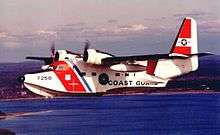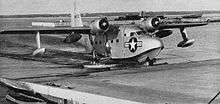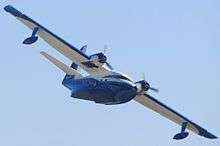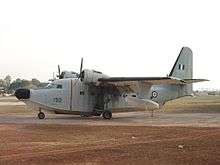Grumman HU-16 Albatross
| HU-16 Albatross | |
|---|---|
 | |
| Restored US Navy HU-16C BuNo 131906, built June 1953 | |
| Role | Air-sea rescue flying boat |
| Manufacturer | Grumman |
| First flight | October 24, 1947[1] |
| Introduction | 1949 |
| Retired | 1995 (Hellenic Navy) |
| Status | Limited Civilian Service |
| Primary users | United States Air Force United States Coast Guard United States Navy Hellenic Navy |
| Produced | 1949–1961 |
| Number built | 466 |


The Grumman HU-16 Albatross is a large twin–radial engine amphibious flying boat that was used by the United States Air Force (USAF), the U.S. Navy (USN) and the U.S. Coast Guard (USCG), primarily as a search and rescue aircraft. Originally designated as the SA-16 for the USAF and the JR2F-1 and UF-1 for the USN and USCG, it was redesignated as the HU-16 in 1962.
Design and development
An improvement of the design of the Grumman Mallard, the Albatross was developed to land in open ocean situations to accomplish rescues. Its deep-V hull cross-section and keel length enable it to land in the open sea. The Albatross was designed for optimal 4-foot (1.2 m) seas, and could land in more severe conditions, but required JATO (jet-assisted take off, or simply booster rockets) for takeoff in 8–10-foot (2.4–3.0 m) seas or greater.
Operational history
The majority of Albatrosses were used by the U.S. Air Force, primarily in the search and rescue mission role (SAR), and initially designated as SA-16. The USAF used the SA-16 extensively in Korea for combat rescue, where it gained a reputation as a rugged and seaworthy craft. Later, the redesignated HU-16B (long-wing variant) Albatross was used by the U.S. Air Force's Aerospace Rescue and Recovery Service and saw extensive combat service during the Vietnam War. In addition a small number of Air National Guard air commando groups were equipped with HU-16s for covert infiltration and extraction of special forces from 1956 to 1971.[2] Other examples of the HU-16 made their way into Air Force Reserve air rescue units prior to its retirement from USAF service.
The U.S. Navy also employed the HU-16C/D Albatross as a search and rescue (SAR) aircraft from coastal naval air stations, both stateside and overseas. It was also employed as an operational support aircraft worldwide and for missions from the former NAS Agana, Guam during the Vietnam War. Goodwill flights were also common to the surrounding Trust Territory of the Pacific Islands in the early 1970s. Open water landings and water takeoff training using JATO was also conducted frequently by U.S. Navy HU-16s from locations such as NAS Agana, Guam; Naval Station Guantanamo Bay, Cuba; NAS Barbers Point, Hawaii; NAS North Island, California, NAS Key West, Florida; NAS Jacksonville, Florida and NAS Pensacola, Florida, among other locations.
The HU-16 was also operated by the U.S. Coast Guard as both a coastal and long-range open ocean SAR aircraft for many years until it was supplanted by the HU-25 Guardian and HC-130 Hercules.
The final USAF HU-16 flight was the delivery of AF Serial No. 51-5282 to the National Museum of the United States Air Force at Wright-Patterson AFB, Ohio in July 1973 after setting an altitude record of 32,883 ft earlier in the month.
The final US Navy HU-16 flight was made 13 August 1976 when an Albatross was delivered to the National Museum of Naval Aviation at NAS Pensacola, Florida.[3]
The final USCG HU-16 flight was at CGAS Cape Cod in March 1983, when the aircraft type was retired by the USCG. The Albatross continued to be used in the military service of other countries, the last being retired by the Hellenic Navy (Greece) in 1995.
The Royal Canadian Air Force operated Grumman Albatross's with the designation "CSR-110" rather than the US (post 1962) standard of "HU-16".
Civil operations


In the mid-1960s the U.S. Department of the Interior acquired 3 military Grumman HU-16's from the U.S. Navy and established the Trust Territory Airlines in the Pacific to serve the islands of Micronesia. Pan American World Airways and finally Continental Airlines' Air Micronesia operated the Albatrosses serving Yap, Palau, Chuuk (Truk) and Pohnpei from Guam until 1970, when adequate island runways were built, allowing land operations.
In 1970, Conroy Aircraft marketed a remanufactured HU-16A with Rolls-Royce Dart turboprop engines as the Conroy Turbo Albatross, but only one prototype (registration N16CA) was ever built.
Many surplus Albatrosses were sold to civilian operators, mostly to private owners. These aircraft are operated under either Experimental-Exhibition or Restricted category and cannot be used for commercial operations, except under very limited conditions.
In the early 1980s Chalk's International Airlines owned by Merv Griffin's Resorts International had 13 Albatrosses converted to Standard category as G-111s. This made them eligible to be used in scheduled airline operations. These aircraft had extensive modification from the standard military configuration, including rebuilt wings with titanium wing spar caps, additional doors and modifications to existing doors and hatches, stainless steel engine oil tanks, dual engine fire extinguishing systems on each engine and propeller auto feather systems installed. The G-111s were operated for only a few years and then put in storage in Arizona. Most are still parked there, but some have been returned to regular flight operations with private operators.
Currently, satellite technology company Row 44 uses an HU-16B Albatross (registration "N44HQ")[4] to test its in-flight satellite broadband internet service. Purchased, restored and named Albatross One in 2008, the company selected this aircraft for its operations because it has the same curvature atop its fuselage as the Boeing 737 aircraft for which the company manufactures its equipment. The plane purchased by Row 44 was used at one time as a training aircraft for space shuttle astronauts by NASA. It features the autographs of the astronauts who trained aboard the plane on one of the cabin walls.[5][6]
In 1997 a Grumman Albatross (N44RD), piloted by Reid Dennis and Andy Macfie, became the first Albatross to circumnavigate the globe. The 26,347 nmi flight around the world lasted 73 days, included 38 stops in 21 countries, and was completed with 190 hours of flight time.[7] In 2013 Reid Dennis donated N44RD to the Hiller Aviation Museum.[8]
Since the aircraft weighs over 12,500 pounds, pilots of civilian US-registered Albatross aircraft must have a type rating. There is a yearly Albatross fly-in at Boulder City, Nevada where Albatross pilots can become type rated.
Variants

- XJR2F-1 - Prototype designation, two built.
- HU-16A (originally SA-16A) - USAF version
- HU-16A (originally UF-1) - Indonesian version

- HU-16B (originally SA-16B) - USAF version (modified with long wing)
- SHU-16B (modified HU-16B for Anti-Submarine Warfare) - export version
- HU-16C (originally UF-1) - US Navy version
- LU-16C (originally UF-1L) - US Navy version
- TU-16C (originally UF-1T) - US Navy version
- HU-16D (originally UF-1) - US Navy version (modified with long wing)
- HU-16D (originally UF-2) - German version (built with long wing)
- HU-16E (originally UF-1G) - US Coast Guard version (modified with long wing)
- HU-16E (originally SA-16A) - USAF version (modified with long wing)
- G-111 (originally SA-16A) - derived from USAF, JASDF, and German originals)
- CSR-110 - RCAF version[9]
Operators

- Royal Canadian Air Force - retired with 442 Transport and Rescue Squadron
- Italian Air Force operated 13 Grumman HU-16A Albatross from 1958 until 1979 [10]

Aircraft on display

- Note
- many of this type are still in active use.
- HU-16A
- AF Ser. No. 51-0006 - Strategic Air and Space Museum in Ashland, Nebraska.[11]
- AF Ser. No. 51-0022 - Pima Air and Space Museum adjacent to Davis-Monthan AFB in Tucson, Arizona.[12]
- AF Serial No. 51-5282, at the National Museum of the United States Air Force, Wright-Patterson AFB, Ohio. This was USAF's last operational HU-16. On 4 July 1973 it established a world record for twin-engine amphibians when it reached 32,883 feet and was transferred to the Air Force Museum two weeks later.[13]
- AF Ser. No. 51-7144 - Museum of Aviation, Robins AFB, Georgia.[14]
- AF Ser. No. 51-7163 - Castle Air Museum adjacent to the former Castle AFB, Atwater, California.[15]
- AF Ser. No. 51-7176 - Coast Guard Air Station Clearwater, Florida. It was previously at the Pate Museum of Transportation in Cresson, Texas until its disassembly and relocation to CGAS Clearwater for restoration. It is currently marked as USCG 1023.[16]
- AF Ser. No. 51-7193 - Maryland Air National Guard Museum, Warfield Air National Guard Base, Baltimore, Maryland.[17]
- AF Ser. No. 51-7195 - Yanks Air Museum, Chino, California.[18]
- AF Ser. No. 51-7200 - Octave Chanute Aerospace Museum, former Chanute AFB, Rantoul, Illinois.[19]
- HU-16C
- BuNo 137928 hemisphere dancer - Universal Studios, Orlando, Florida.[20] Former USN aircraft in civilian markings, previously owned by musician and pilot Jimmy Buffett
- BuNo 137932 - Hiller Aviation Museum, San Carlos, California, N44RD formerly owned by Reid W. Dennis.[21]
- HU-16E
- AF Ser. No. 51-7209 - Aerospace Museum of California, former McClellan AFB, Sacramento, California.[22]
- AF Ser. No. 51-7216 - Floyd Bennett Field, New York City, New York.[23]
- AF Ser. No. 51-7228 - New England Air Museum, Windsor Locks, Connecticut.[24]
- USCG 7236 - National Museum of Naval Aviation, NAS Pensacola, Florida.[25]
- AF Ser. No. 51-7245, then USCG 7245 - Pacific Coast Air Museum, Santa Rosa, California.[26] Originally served in USAF, transferred to USCG circa 1957-58.
- AF Ser. No. 51-7247, then USCG 7247 - Coast Guard Air Station Elizabeth City, North Carolina.[27]
- AF Ser. No. 51-7250, the USCG 7250 - Coast Guard Air Station Cape Cod, Massachusetts.[28]
- AF Ser. No. 51-7251 - Dyess Linear Air Park, Dyess AFB, Texas.[29]
- AF Ser. No. 51-7254 - Jimmy Doolittle Air & Space Museum, Travis AFB, Fairfield, California.[30]
- AF Ser. No. 52-1280 - Kirtland AFB, Albuquerque, New Mexico.[31]
- USCG 1293 - March Field Air Museum, March ARB, Riverside, California.[32]
- USCG 2129 - Battleship Memorial Park, Mobile, Alabama.[33]
- USCG 7236 - National Museum of Naval Aviation, NAS Pensacola, Florida[34]
- SA-16B
- BS-02 - Museo Nacional de Aeronáutica de Argentina, at Moron, Buenos Aires, Argentina.[35]
Accidents and incidents
- On 24 January 1952, SA-16A Albatross, 51-001, c/n G-74,[36] of the 580th Air Resupply Squadron (described as a Central Intelligence Agency air unit), on cross-country flight from Mountain Home AFB, Idaho, to San Diego, California, suffered failure of the port engine over Death Valley. The crew of six successfully bailed out at ~18:30 with no injuries, walked south some 14 miles (23 km) to Furnace Creek, California where they were picked up the following day by an SA-16 from the 42nd Air Rescue Squadron, March AFB, California. The abandoned SA-16 crashed into Towne Summit mountain ridge of the Panamint Range west of Stovepipe Wells with the starboard engine still running. The wreckage is still there.[37]
- On 18 June 1965, on the very first Operation Arc Light mission flown by B-52 Stratofortresses of Strategic Air Command to hit a target in South Vietnam, two aircraft collided in the darkness. Eight crew were killed, but four survivors were located and picked up by an HU-16A-GR Albatross amphibian, AF serial number 51-5287. The Albatross was damaged on take-off by a heavy sea state and those on board had to transfer to a Norwegian freighter and a Navy vessel, the aircraft sinking thereafter.[38]
- On 9 January 1966, a Republic of China HU-16 carrying three mainland Chinese naval defectors was shot down by communist MiGs over the Straits of Formosa, just hours after they had surrendered their landing ship and asked for asylum. The Albatross was attacked just 15 minutes after departing the island of Matsu on a 135 mile flight to Taipei. According to a U.S. Defense Department announcement, the attack was a swift—and perhaps intentional—retribution for the communist sailors who killed seven fellow crew members during their predawn escape to freedom.[39]
- On 23 April 1966, a Royal Canadian Air Force Grumman CSR-110 Albatross (9302) serving with No. 121 Composite Unit (KU) at RCAF Station Comox, BC crashed on the Hope Slide near Hope, BC. It was the only RCAF Albatross loss. Five of the six crew members died (Squadron Leader J. Braiden, Flying Officer Christopher J. Cormier, Leading Aircraftsman Robert L. McNaughton, Flight Lieutenant Phillip L. Montgomery, and Flight Lieutenant Peter Semak). Flying Officer Bob Reid was the sole survivor. A portion of the wreckage is still visible and can be hiked to.
- On 5 March 1967, U.S. Coast Guard HU-16E Albatross, Coast Guard 1240, c/n G-61, out of Coast Guard Air Station St. Petersburg, Florida, deployed to drop a dewatering pump to a sinking 40-foot (12 m) yacht, "Flying Fish", in the Gulf of Mexico off of Carrabelle, Florida. Shortly after making a low pass behind the sinking vessel to drop the pump, the flying boat crashed a short distance away, with loss of all six crew. The vessel's crew heard a loud crash but could see nothing owing to fog. The submerged wreck was not identified until 2006.[40][41]
- On 7 August 1967, U.S. Coast Guard HU-16E Albatross, Coast Guard 2128, c/n G-355, (ex-USAF SA-16A, 52-128), out of CGAS San Francisco, returning from a search mission for an overdue private cabin cruiser Misty (which had run out of fuel) in the Pacific Ocean off of San Luis Obispo, struck a slope of Mount Mars near the Monterey-San Luis Obispo County line, about 0.5 miles (0.80 km) east of Highway 1. The airframe broke in two, killing two crew immediately and injuring four others, with one dying in hospital several days later.[42]
- On 5 November 2009, Albatross N120FB of Albatross Adventures crashed shortly after take-off from St. Lucie County International Airport, Fort Pierce, Florida. An engine failed shortly after take-off; the aircraft was damaged beyond economic repair.[43]
Specifications (HU-16B)
Data from Albatross: Amphibious Airborne Angel [44]
General characteristics
- Crew: 4-6
- Capacity: 10 passengers
- Length: 62 ft 10 in (19.16 m)
- Wingspan: 96 ft 8 in (29.47 m)
- Height: 25 ft 10 in (7.88 m)
- Wing area: 1035 ft²[45] (96.2 m²)
- Empty weight: 22,883 lb (10,401 kg)
- Loaded weight: 30,353 lb (13,797 kg)
- Max. takeoff weight: 37,500 lb (17,045 kg)
- Fuel Capacity: 675 US Gallons (2,555 L) internally, plus 400 US Gal (1,514 L) in wingtip floats plus two 300 US Gallon (1,136 L) drop tanks
- Powerplant: 2 × Wright R-1820-76 Cyclone 9 nine-cylinder single-row air-cooled radial engine, 1,425 hp (1,063 kW) each
Performance
- Maximum speed: 205 knots (236 mph, 380 km/h)
- Cruise speed: 108 knots (124 mph, 200 km/h)
- Stall speed: 64 knots (74 mph, 119 km/h)
- Range: 2,478 nmi (2,850 mi, 4,589 km)
- Service ceiling: 21,500 ft (6,550 m)
- Rate of climb: 1,450 ft/min (7.4 m/s)
Armament
- None
Notable appearances in media
Featured in the motion pictures Flight from Ashiya, The Expendables and In Harm's Way.
See also
- Related development
- Aircraft of comparable role, configuration and era
References
- ↑ Pigott, Peter (2001). Wings across Canada: an illustrated history of Canadian aviation. Dundurn Press. p. 121. ISBN 1-55002-412-4.
- ↑ Minami, Wayde. "Albatross Was a Maryland Air Guard Classic". 175th Wing, Air National Guard.
- ↑ Grossnick, Roy A. "Part 10: The Seventies 1970–1980" (PDF). United States Naval Aviation 1910–1995 (PDF). Washington, D.C.: Naval Historical Center Department of the Navy. pp. 279–330.
- ↑ "FAA Aircraft Registry N44HQ". Federal Aviation Administration. Retrieved 4 December 2011.
- ↑ "Albatross One". row44.com. Retrieved 4 December 2011.
- ↑ "Speedy In-Flight Wi-Fi, Even During a Wild Ride". The New York Times. 17 October 2011. Retrieved 4 December 2011.
- ↑ Foreman, Herb (March 11, 2013). "Record Holding Albatross Retires to Hiller Aviation Museum". In Flight USA. Retrieved 27 August 2014.
- ↑ Murtagh, Heather (April 29, 2013). "Hiller gets amphibious contribution". San Mateo Daily News. Retrieved 27 August 2014.
- ↑ Wolfe, Ray. "Albatross Current Status List". Grumman Albatross Research.
- ↑ aeroflight
- ↑ "HU-16 Albatross/51-0006". Strategic Air and Space Museum. Retrieved 9 September 2012.
- ↑ "HU-16 Albatross/51-0022". Pima Air and Space Museum. Retrieved 9 September 2012.
- ↑ "HU-16 Albatross/51-5282". National Museum of the US Air Force. Retrieved 29 August 2015.
- ↑ "HU-16 Albatross/51-7144". Museum of Aviation. Retrieved 9 September 2012.
- ↑ "HU-16 Albatross/51-7163". Castle Air Museum. Retrieved 9 September 2012.
- ↑ "HU-16 Albatross/51-7176". Pier System. Retrieved 9 September 2012.
- ↑ "HU-16 Albatross/51-7193". Aero Web. Retrieved 9 September 2012.
- ↑ "HU-16 Albatross/51-7195". Yanks Air Museum. Retrieved 9 September 2012.
- ↑ "HU-16 Albatross/51-7200". Octave Chanute Aerospace Museum. Retrieved 9 September 2012.
- ↑ "HU-16 Albatross/137928". Buffett World. Retrieved 9 September 2012.
- ↑ Highton, Scott. "Virtual Reality Tour Grumman Albatross HU-16C". Hiller Aviation Museum. Retrieved 27 August 2014.
- ↑ "HU-16 Albatross/51-7209". Aerospace Museum of California. Retrieved 20 September 2012.
- ↑ "HU-16 Albatross/51-7216". Aero Web. Retrieved 9 September 2012.
- ↑ "HU-16 Albatross/51-7228". New England Aviation Museum. Retrieved 9 September 2012.
- ↑ "HU-16 Albatross/51-7236". National Museum of Naval Aviation. Retrieved 9 September 2012.
- ↑ "HU-16 Albatross/51-7245". Pacific Coast Air Museum. Retrieved 9 September 2012.
- ↑ "HU-16 Albatross/51-7247". Warbirds Resource Group. Retrieved 9 September 2012.
- ↑ "HU-16 Albatross/51-7250". HU-16 Museums. Retrieved 9 September 2012.
- ↑ "HU-16 Albatross/51-7251". Aero Web. Retrieved 9 September 2012.
- ↑ "HU-16 Albatross/51-7254". Jimmy Doolittle Museum. 9 September 2012.
- ↑ "HU-16 Albatross/1280". Aero Web. Retrieved 9 September 2012.
- ↑ "HU-16 Albatross/1293". March Field Air Museum. Retrieved 9 September 2012.
- ↑ "HU-16 Albatross/2129". USS Alabama Museum. Archived from the original on 4 September 2012. Retrieved 9 September 2012.
- ↑ "Aircraft on Display". National Naval Aviation Museum.
- ↑ Esteban Brea (2012-03-13). "Museo Nacional de Aeronáutica: Más de medio siglo de preservación" [National Aeronautics Museum: More than half a century of preservation] (in Spanish). Gaceta Aeronautica. Retrieved 4 June 2014.
- ↑ "1951 USAF Serial Numbers". Joebaugher.com. Retrieved 25 November 2010.
- ↑ "Albatross Plane Crash Site". Death-Valley.net. Retrieved 25 November 2010.
- ↑ Schlight, John (1988). The War in South Vietnam: The Years of the Offensive, 1965-1968 (The United States Air Force in Southeast Asia). Washington, D.C.: Office of Air Force History, United States Air Force. p. 52. ISBN 0-912799-51-X.
- ↑ "Migs [sic] Shoot Down Unarmed Chinese Plane". Playground Daily News. 19 (342). Fort Walton Beach, FL. United Press International. 10 January 1966. p. 2.
- ↑ Barnette, Michael (2008). Florida's Shipwrecks. Images of America. Charleston, SC: Arcadia Publishing. p. 122. ISBN 978-0-7385-5413-6.
- ↑ "Coast Guard Plane Feared Lost in Gulf". Star-News. Pasadena, CA. United Press International. 6 March 1967.
- ↑ Freeze, Ken (7 August 1967). "Mt. Mars USCG HU-16E Crash". Jacksjoint.com.
- ↑ "Accident description". Aviation Safety Network. Retrieved 7 November 2009.
- ↑ Dorr, Robert F. (October 1991). "Albatross: Amphibious Airborne Angel". Air International. 41 (4): 193–201. ISSN 0306-5634.
Further reading
- Núñez Padin, Jorge Felix (2009). Núñez Padin, Jorge Felix, ed. JRF Goose, PBY Catalina, PBM Mariner & HU-16 Albatros. Serie Aeronaval (in Spanish). 25. Bahía Blanca, Argentina: Fuerzas Aeronavales. ISBN 9789872055745. Retrieved 2015-01-26.
External links
| Wikimedia Commons has media related to Grumman HU-16 Albatross. |
- Historical Aircraft page on Northrop Grumman Web Site
- HU-16 history, including other designations
- The Grumman Albatross Site
- Summary at Coast Guard Historian's site
